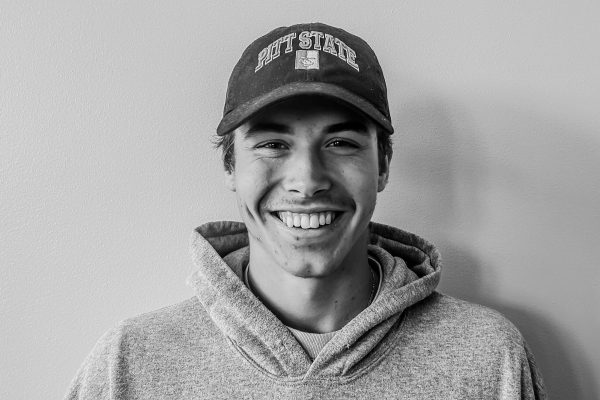Healthcare During COVID-19
May 19, 2020
In Iowa, the number of COVID-19 cases is roughly doubling every five weeks, with about five hundred cases every day. As of right now, Iowa has yet to reach its predicted peak. That means that the number of cases will continue to increase until it does so.
“‘Flattening the curve’ is an epidemiological term to describe where we are in an epidemic. As the infection spreads, it reaches a peak,” Eli Perencevich, MD, a professor of Internal Medicine, infectious diseases, and Epidemiology at the University of Iowa Carver College of Medicine, said. “We want that peak to be lower, with fewer cases per day, so that we don’t overwhelm our healthcare system. Flattening the peak is about squashing the curve so it’s shorter over a longer period of time without overwhelming our healthcare system.”
While traveling internationally has slowed since the implementation of travel restrictions and the closing of borders to several foreign countries, there are far fewer constraints on intrastate travel.
“This is one measure to try to decrease the chance of students getting infected while abroad. Travel plans can also get disrupted while abroad because of the epidemic,” Jorge Salinas, MD, a Hospital Epidemiologist, Clinical Assistant Professor of Internal Medicine, and Infectious Diseases, said. “Patients could get sick also while abroad, where there may not be enough healthcare capacity.”
Both Perencevich and Salinas have given advice on how to do your part to flatten the curve for the benefit of healthcare workers and the at-risk people around you.
“To prevent the spread of the virus, [you should] wash your hands often, [practice] the proper cough etiquette, and social distance, especially if you are sick,” Salinas said. “Distance education is feasible and can help decrease the spread of the disease. When to implement such measures and for how long is a difficult decision that needs to be taken in conjunction with state public health officials.”
Health care workers are still at risk even when they aren’t at hospitals. Following the recommendations of experts and CDC guidelines can ensure they remain able to do their jobs.
“If healthcare workers have personal protective equipment like face shields, masks, respirators, gowns and gloves, they’re unlikely to catch the virus in the hospital setting,” said Perencevich. “But they’re equally likely as anyone else to catch it in the community. So, if they’re commuting to work on a bus or subway, they could catch it there.”
With the partial reopening of Iowa set for early May, healthcare researchers warn of a possible second wave of the virus. A second peak could further overwhelm the healthcare system and undo the effects of the past nine weeks of social distancing across the state.
In an interview with NBC, Dr. Anthony Fauci, a member of the White House coronavirus task force and one of the government’s top infectious disease experts, said he was “cautiously optimistic” about reopening. However, he also gave a warning.
“When you pull back, there will be cases,” Fauci said. “And what we need to do is make sure they have in place the capability of identifying, isolating, and contact-tracing individuals.”
Iowa City, and the rest of Johnson County, will remain closed until May 15 along with 21 other Iowa counties.
“I think Johnson County and Iowa City have been fantastic. They’ve done everything possible to encourage flattening the curve, encourage people to stay home, close in the appropriate businesses, and send the right messages,” said Perencevich. “I worry that the state of Iowa is opening up too early because a lot of our rural counties don’t have enough testing to know how much COVID-19 disease is there. So, we [shouldn’t] safely open up until we increase our testing capacity.”
The problem that a limited number of tests pose is that, in the 77 counties opened May 1, there could be more people infected who are asymptomatic, untested, or unreported. The number of cases, and deaths, are still on the upward trend of exponential growth according to the NYT and KCII Des Moines. Both sites have corroborating graphs that show that Iowa’s cases-per-day are in the hundreds.
“We don’t have that many people that live in Iowa, we have a small population of only three million people, so 500 cases for us is a lot of cases,” said Perencevich “But I think the key is that we need to see that flatten, so we want to see no more than 500 cases for five or seven days in a row or declining numbers of cases where we’re doing tons of testing but only finding three or 200 cases and in that point, it’s become safer to open up. You shouldn’t open up until several weeks after your peak.”
The consequences of opening up too soon could be devastating on the healthcare system as a whole, including healthcare workers, small hospitals, and patients.
“A lot of small hospitals are going bankrupt because they can’t do elective procedures. They’re caring for COVID patients, but not being able to bill insurance companies. A lot of hospitals, very huge financial stress,” said Perencevich. “I think the sad thing is that insurance companies have all the money for health care but they don’t have to send it to hospitals because hospitals are doing procedures and billing so the system is really broken.”
































